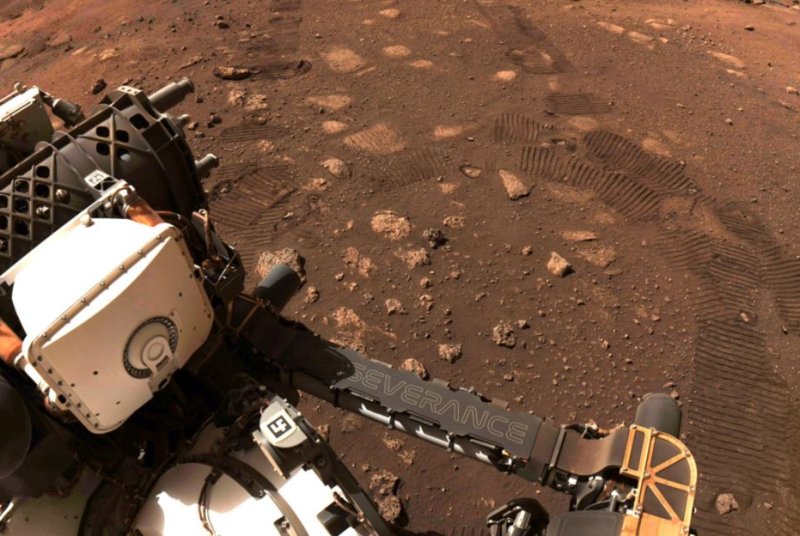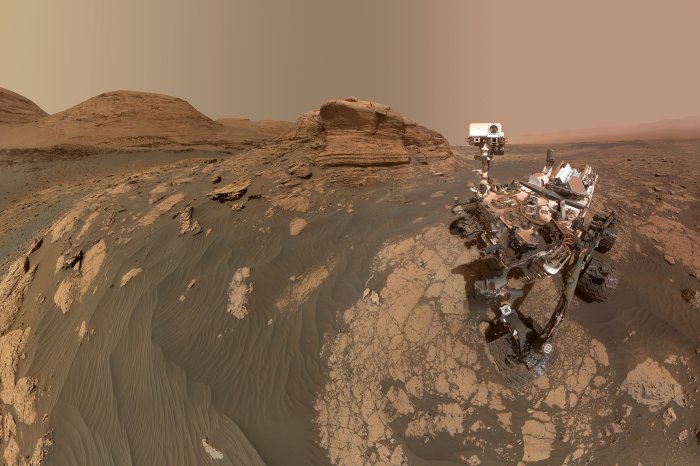1 of 5 | NASA's Mars rover Perseverance is shown on the surface of the planet after making its first drive March 4, the start of its mission to hunt for signs of life on the Red Planet. Photo courtesy of NASA
ORLANDO, Fla., April 16 (UPI) -- NASA plans to launch its next mission to Mars in 2026 to pick up rock samples being collected over the next two years and collaborate on their return to Earth by 2031, officials said.
The Mars rover Perseverance, which landed on the planet Feb. 18, will drill rock samples in an ancient river delta. Such a location, once flowing with water, is the best spot to look for signs of past life, according to NASA.
Those samples are to be returned to Earth for high-tech analysis that couldn't be done by a rover no matter how sophisticated, Don Brownlee, professor of astronomy at University of Washington at Seattle, said during a press conference Thursday hosted by Lockheed Martin's center in Littleton, Colo.
"The biggest instruments we've used to analyze returned samples [from other missions] were synchrotrons, which can be as big as a shopping center," Brownlee said during the online session.
Brownlee is the principal scientist investigating samples returned from the comet Wild 2 in 2006 by NASA's Stardust spacecraft.
"We're also asking questions today about samples that would never have occurred to us prior to the Stardust mission," Brownlee said, adding that he expects Mars samples to inspire generations of new science.
NASA next week plans to review system requirements for the Mars sample return spacecraft and rover, David Mitchell, director of the space agency's Engineering and Technology Directorate, said during the news conference.
The rover will land on Mars near Perseverance's location, retrieve roughly 30 or more samples and bring them back to a lander that will carry them into Mars orbit, Mitchell said.
A third spacecraft, built by the European Space Agency, will be launched in 2026, travel to Mars and collect the samples in orbit, flying back to Earth by 2031. The samples from Mars will be locked away in a secure facility to ensure they contain nothing harmful or toxic, Mitchell said.
"And then over time, they'll be released to our science community in some manner to be determined based on what we see in the samples," he said.
NASA chose the location for the Perseverance mission, Jezero Crater, because it is among the best preserved ancient river deltas and lake beds on Mars, said Jennifer Trosper, deputy project manager for the Perseverance mission.
"Lakes and rivers on Earth are great places to preserve ancient life, and so we think this is a great place, if ancient life ever existed on Mars, to be able to find it," Trosper said.
NASA’s Curiosity Mars rover used two different cameras to create this panoramic selfie, comprised of 60 images, in front of Mont Mercou, a rock outcrop that stands 20 feet tall on March 26, 2021, the 3,070th Martian day, or sol, of the mission. These were combined with 11 images taken by the Mastcam on the mast, or "head," of the rover on March 16. The hole visible to the left of the rover is where its robotic drill sampled a rock nicknamed "Nontron." The Curiosity team is nicknaming features in this part of Mars using names from the region around the village of Nontron in southwestern France. Photo courtesy of NASA/JPL-Caltech/MSSS
















